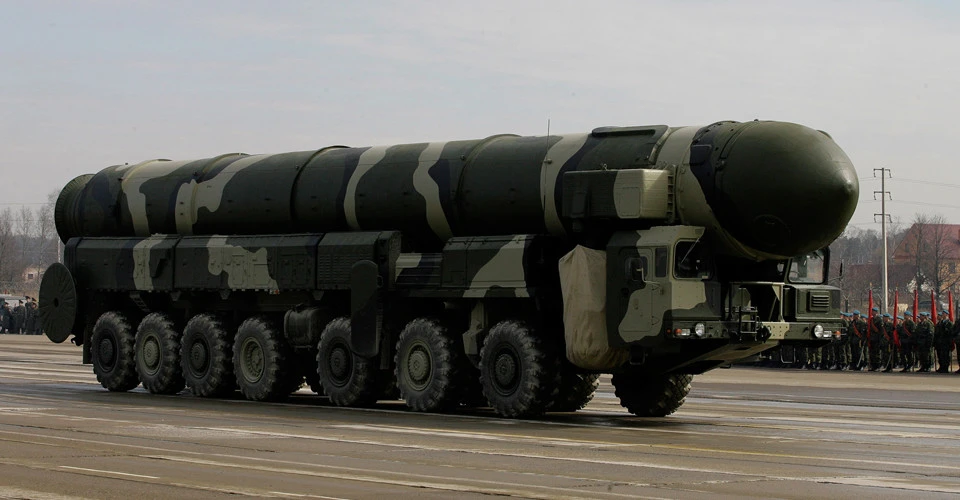What Russia's Oreshnik threats mean ahead of Alaska summit
global.espreso.tv
Fri, 15 Aug 2025 14:58:00 +0300

Contents1. “Nuclear component” in Russian military exercises prior to the invasion of Ukraine2. Role and functions of the “nuclear component” for the Russian Federation in 2014-20223. How Russia is building “nuclear blackmail” during a full-scale invasionEverything is being done with one goal in mind: on the eve of the Trump-Putin meeting, Russia is trying to create the most tense situation possible, demonstrating initiative on the battlefield against Ukraine and in the European theater of war in general. The Zapad 2025 exercises play an important role in this situation. In fact, they are being used by the Kremlin as a tool of strategic uncertainty, heightening fears of a repeat of February 2022 for Ukraine, or an attack on the Baltic states or Poland. We discussed this in detail in the publication Zapad-2025: Exercises in Belarus as Hybrid Blackmail of Ukraine and NATO. However, just hours after the article was published, a statement from the Belarusian Ministry of Defense about Oreshnik appeared. Therefore, it is worth returning to this topic.“Nuclear component” in Russian military exercises prior to the invasion of UkraineAccording to our estimates, the most realistic scenario for the developments surrounding the exercises in Belarus is a hybrid operation involving active information and psychological warfare against Ukraine and the West. Therefore, Russia is using nuclear blackmail to increase informational pressure, emphasizing that the Zapad 2025 exercises are not just a threat of a conventional attack on NATO countries and Ukraine, but also a rehearsal for nuclear strikes against Europe and the U.S.At a press conference on August 13, Belarusian Defense Minister Khrenin stated that elements of nuclear weapons deployment planning and the Oreshnik exercise would be practiced during the Zapad 2025 exercises. According to him, this is an important element of strategic deterrence for Belarus and Russia, adding that “nuclear weapons are capable of inflicting unacceptable damage on potential adversaries.”In fact, the use of nuclear missiles during strategic exercises by the Russian Armed Forces is more the norm than an unusual element. After the collapse of the USSR, Russia inherited not only the world's largest arsenal of nuclear weapons, but also the Soviet concept, in which the nuclear component was integrated into strategic planning as an instrument of political pressure and military blackmail. Over the past 30 years, Russia has regularly conducted strategic exercises such as Zapad, Tsentr, and Vostok (in various strategic directions), as well as separate strategic training exercises for “deterrent forces” (in particular, the Grom exercise). During these exercises, which had conventional scenarios, nuclear strikes were also practiced to deliver a final defeat to the enemy: from the adoption of a political decision to demonstration launches of intercontinental ballistic missiles (ICBMs) and tactical nuclear delivery systems.At the same time, it was Putin's rise to power in the early 2000s that marked a course toward restoring imperial nuclear prestige, which influenced the nature and scenarios of strategic exercises. In particular, the scenario of the Zapad 2009 exercises included elements of the use of tactical nuclear weapons against a hypothetical NATO country. It was this episode that sparked a discussion about the so-called concept of “nuclear escalation for de-escalation” in the Russian Federation's military doctrine. At the same time, during joint exercises, Topol-M ICBMs, Sineva sea-based missiles, and air-based cruise missiles were regularly launched. Role and functions of the “nuclear component” for the Russian Federation in 2014-2022After the war against Ukraine began in 2014, the nuclear factor became an even more prominent element of large-scale exercises. Center-2015 practiced strategic defense, taking into account the possibility of escalation to the nuclear level. Zapad 2017 featured a training launch of the RS-24 Yars ICBM. Although the main scenario remained conventional (albeit emphatically aggressive towards NATO countries), the demonstration of strategic missile launches was a clear signal to the West about the Kremlin's ambitions. In 2018, in parallel with Vostok-2018, there were demonstrative flights of strategic aircraft (Tu-95MS) near Alaska, which had the characteristics of a nuclear signal, although there were no confirmed launches during the maneuvers themselves. This period culminated in the Grom-2019 exercises, during which Russia, for the first time in the post-Soviet era, rehearsed a massive scenario of a “strategic deterrence operation” with multiple launches of ICBMs (Yars), BRPC (Sineva), and air- and sea-based cruise missiles.
Role and functions of the “nuclear component” for the Russian Federation in 2014-2022After the war against Ukraine began in 2014, the nuclear factor became an even more prominent element of large-scale exercises. Center-2015 practiced strategic defense, taking into account the possibility of escalation to the nuclear level. Zapad 2017 featured a training launch of the RS-24 Yars ICBM. Although the main scenario remained conventional (albeit emphatically aggressive towards NATO countries), the demonstration of strategic missile launches was a clear signal to the West about the Kremlin's ambitions. In 2018, in parallel with Vostok-2018, there were demonstrative flights of strategic aircraft (Tu-95MS) near Alaska, which had the characteristics of a nuclear signal, although there were no confirmed launches during the maneuvers themselves. This period culminated in the Grom-2019 exercises, during which Russia, for the first time in the post-Soviet era, rehearsed a massive scenario of a “strategic deterrence operation” with multiple launches of ICBMs (Yars), BRPC (Sineva), and air- and sea-based cruise missiles. How Russia is building “nuclear blackmail” during a full-scale invasionAfter the full-scale invasion of Ukraine, nuclear rhetoric and the nature of military exercises became even more aggressive. Vostok-2022 and strategic exercises in 2022–2024 included launches of Yars ICBMs and Bulava and Sineva sea-based missiles, demonstrating the technical readiness of the triad. In 2023–2025, Russia conducted tests of modernized Yars-S ICBMs and Avangard hypersonic units and continued training with tactical nuclear weapons in Belarus after their (unofficially confirmed) deployment in 2023.Against this backdrop, the statement by the Belarusian defense minister regarding the possible testing of elements of nuclear weapons and the Oreshnik complex during the Zapad 2025 exercises not only confirms the consistent trend toward expanding the nuclear component of strategic exercises, but also fits into the general logic of recent decades: the use of military maneuvers as a tool for informational and diplomatic pressure on NATO countries and a demonstration of Russia's ambitions to maintain its status as a “global power.”In general, the nuclear component currently performs several specific tasks during Russia's strategic exercises:1. Rehearsing command and staff procedures — integrating political and military leadership (including Belarus) into the process of deciding on a nuclear strike.2. Testing the readiness of the triad — real launches of ICBMs, SLBMs, and cruise missiles, testing new systems.3. Psychological pressure — demonstrating readiness for escalation in a crisis.4. Signal to external players — blurring the line between tactical and strategic nuclear weapons, as well as conventional warfare and the use of nuclear instruments.In fact, the use of nuclear blackmail and the brandishing of the Oreshnik during the Zapad-2025 strategic exercises is a natural continuation of Putin's neo-imperial strategy. Zapad 2025 involves exerting intense hybrid influence on Ukraine and NATO countries, including through active information and psychological operations and military provocations. In this sense, threats to test the Oreshnik should not be perceived as a military threat, but rather as an attempt at psychological pressure against the backdrop of the continuing aggressive war against Ukraine and the Trump-Putin meeting, which could potentially mark the beginning of the destruction of Putin's empire if the U.S. and its European allies demonstrate strength and uncompromising diplomatic and economic pressure on Russia.This material was prepared in cooperation with the Consortium for Defense Information (CDI), a project that brings together Ukrainian analytical and research organizations and aims to strengthen information support and analytical capabilities in the field of national security, defense, and geopolitics.
How Russia is building “nuclear blackmail” during a full-scale invasionAfter the full-scale invasion of Ukraine, nuclear rhetoric and the nature of military exercises became even more aggressive. Vostok-2022 and strategic exercises in 2022–2024 included launches of Yars ICBMs and Bulava and Sineva sea-based missiles, demonstrating the technical readiness of the triad. In 2023–2025, Russia conducted tests of modernized Yars-S ICBMs and Avangard hypersonic units and continued training with tactical nuclear weapons in Belarus after their (unofficially confirmed) deployment in 2023.Against this backdrop, the statement by the Belarusian defense minister regarding the possible testing of elements of nuclear weapons and the Oreshnik complex during the Zapad 2025 exercises not only confirms the consistent trend toward expanding the nuclear component of strategic exercises, but also fits into the general logic of recent decades: the use of military maneuvers as a tool for informational and diplomatic pressure on NATO countries and a demonstration of Russia's ambitions to maintain its status as a “global power.”In general, the nuclear component currently performs several specific tasks during Russia's strategic exercises:1. Rehearsing command and staff procedures — integrating political and military leadership (including Belarus) into the process of deciding on a nuclear strike.2. Testing the readiness of the triad — real launches of ICBMs, SLBMs, and cruise missiles, testing new systems.3. Psychological pressure — demonstrating readiness for escalation in a crisis.4. Signal to external players — blurring the line between tactical and strategic nuclear weapons, as well as conventional warfare and the use of nuclear instruments.In fact, the use of nuclear blackmail and the brandishing of the Oreshnik during the Zapad-2025 strategic exercises is a natural continuation of Putin's neo-imperial strategy. Zapad 2025 involves exerting intense hybrid influence on Ukraine and NATO countries, including through active information and psychological operations and military provocations. In this sense, threats to test the Oreshnik should not be perceived as a military threat, but rather as an attempt at psychological pressure against the backdrop of the continuing aggressive war against Ukraine and the Trump-Putin meeting, which could potentially mark the beginning of the destruction of Putin's empire if the U.S. and its European allies demonstrate strength and uncompromising diplomatic and economic pressure on Russia.This material was prepared in cooperation with the Consortium for Defense Information (CDI), a project that brings together Ukrainian analytical and research organizations and aims to strengthen information support and analytical capabilities in the field of national security, defense, and geopolitics.
 Role and functions of the “nuclear component” for the Russian Federation in 2014-2022After the war against Ukraine began in 2014, the nuclear factor became an even more prominent element of large-scale exercises. Center-2015 practiced strategic defense, taking into account the possibility of escalation to the nuclear level. Zapad 2017 featured a training launch of the RS-24 Yars ICBM. Although the main scenario remained conventional (albeit emphatically aggressive towards NATO countries), the demonstration of strategic missile launches was a clear signal to the West about the Kremlin's ambitions. In 2018, in parallel with Vostok-2018, there were demonstrative flights of strategic aircraft (Tu-95MS) near Alaska, which had the characteristics of a nuclear signal, although there were no confirmed launches during the maneuvers themselves. This period culminated in the Grom-2019 exercises, during which Russia, for the first time in the post-Soviet era, rehearsed a massive scenario of a “strategic deterrence operation” with multiple launches of ICBMs (Yars), BRPC (Sineva), and air- and sea-based cruise missiles.
Role and functions of the “nuclear component” for the Russian Federation in 2014-2022After the war against Ukraine began in 2014, the nuclear factor became an even more prominent element of large-scale exercises. Center-2015 practiced strategic defense, taking into account the possibility of escalation to the nuclear level. Zapad 2017 featured a training launch of the RS-24 Yars ICBM. Although the main scenario remained conventional (albeit emphatically aggressive towards NATO countries), the demonstration of strategic missile launches was a clear signal to the West about the Kremlin's ambitions. In 2018, in parallel with Vostok-2018, there were demonstrative flights of strategic aircraft (Tu-95MS) near Alaska, which had the characteristics of a nuclear signal, although there were no confirmed launches during the maneuvers themselves. This period culminated in the Grom-2019 exercises, during which Russia, for the first time in the post-Soviet era, rehearsed a massive scenario of a “strategic deterrence operation” with multiple launches of ICBMs (Yars), BRPC (Sineva), and air- and sea-based cruise missiles. How Russia is building “nuclear blackmail” during a full-scale invasionAfter the full-scale invasion of Ukraine, nuclear rhetoric and the nature of military exercises became even more aggressive. Vostok-2022 and strategic exercises in 2022–2024 included launches of Yars ICBMs and Bulava and Sineva sea-based missiles, demonstrating the technical readiness of the triad. In 2023–2025, Russia conducted tests of modernized Yars-S ICBMs and Avangard hypersonic units and continued training with tactical nuclear weapons in Belarus after their (unofficially confirmed) deployment in 2023.Against this backdrop, the statement by the Belarusian defense minister regarding the possible testing of elements of nuclear weapons and the Oreshnik complex during the Zapad 2025 exercises not only confirms the consistent trend toward expanding the nuclear component of strategic exercises, but also fits into the general logic of recent decades: the use of military maneuvers as a tool for informational and diplomatic pressure on NATO countries and a demonstration of Russia's ambitions to maintain its status as a “global power.”In general, the nuclear component currently performs several specific tasks during Russia's strategic exercises:1. Rehearsing command and staff procedures — integrating political and military leadership (including Belarus) into the process of deciding on a nuclear strike.2. Testing the readiness of the triad — real launches of ICBMs, SLBMs, and cruise missiles, testing new systems.3. Psychological pressure — demonstrating readiness for escalation in a crisis.4. Signal to external players — blurring the line between tactical and strategic nuclear weapons, as well as conventional warfare and the use of nuclear instruments.In fact, the use of nuclear blackmail and the brandishing of the Oreshnik during the Zapad-2025 strategic exercises is a natural continuation of Putin's neo-imperial strategy. Zapad 2025 involves exerting intense hybrid influence on Ukraine and NATO countries, including through active information and psychological operations and military provocations. In this sense, threats to test the Oreshnik should not be perceived as a military threat, but rather as an attempt at psychological pressure against the backdrop of the continuing aggressive war against Ukraine and the Trump-Putin meeting, which could potentially mark the beginning of the destruction of Putin's empire if the U.S. and its European allies demonstrate strength and uncompromising diplomatic and economic pressure on Russia.This material was prepared in cooperation with the Consortium for Defense Information (CDI), a project that brings together Ukrainian analytical and research organizations and aims to strengthen information support and analytical capabilities in the field of national security, defense, and geopolitics.
How Russia is building “nuclear blackmail” during a full-scale invasionAfter the full-scale invasion of Ukraine, nuclear rhetoric and the nature of military exercises became even more aggressive. Vostok-2022 and strategic exercises in 2022–2024 included launches of Yars ICBMs and Bulava and Sineva sea-based missiles, demonstrating the technical readiness of the triad. In 2023–2025, Russia conducted tests of modernized Yars-S ICBMs and Avangard hypersonic units and continued training with tactical nuclear weapons in Belarus after their (unofficially confirmed) deployment in 2023.Against this backdrop, the statement by the Belarusian defense minister regarding the possible testing of elements of nuclear weapons and the Oreshnik complex during the Zapad 2025 exercises not only confirms the consistent trend toward expanding the nuclear component of strategic exercises, but also fits into the general logic of recent decades: the use of military maneuvers as a tool for informational and diplomatic pressure on NATO countries and a demonstration of Russia's ambitions to maintain its status as a “global power.”In general, the nuclear component currently performs several specific tasks during Russia's strategic exercises:1. Rehearsing command and staff procedures — integrating political and military leadership (including Belarus) into the process of deciding on a nuclear strike.2. Testing the readiness of the triad — real launches of ICBMs, SLBMs, and cruise missiles, testing new systems.3. Psychological pressure — demonstrating readiness for escalation in a crisis.4. Signal to external players — blurring the line between tactical and strategic nuclear weapons, as well as conventional warfare and the use of nuclear instruments.In fact, the use of nuclear blackmail and the brandishing of the Oreshnik during the Zapad-2025 strategic exercises is a natural continuation of Putin's neo-imperial strategy. Zapad 2025 involves exerting intense hybrid influence on Ukraine and NATO countries, including through active information and psychological operations and military provocations. In this sense, threats to test the Oreshnik should not be perceived as a military threat, but rather as an attempt at psychological pressure against the backdrop of the continuing aggressive war against Ukraine and the Trump-Putin meeting, which could potentially mark the beginning of the destruction of Putin's empire if the U.S. and its European allies demonstrate strength and uncompromising diplomatic and economic pressure on Russia.This material was prepared in cooperation with the Consortium for Defense Information (CDI), a project that brings together Ukrainian analytical and research organizations and aims to strengthen information support and analytical capabilities in the field of national security, defense, and geopolitics.





